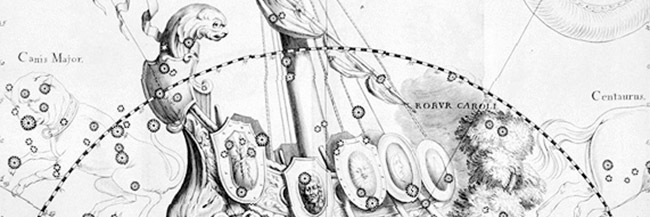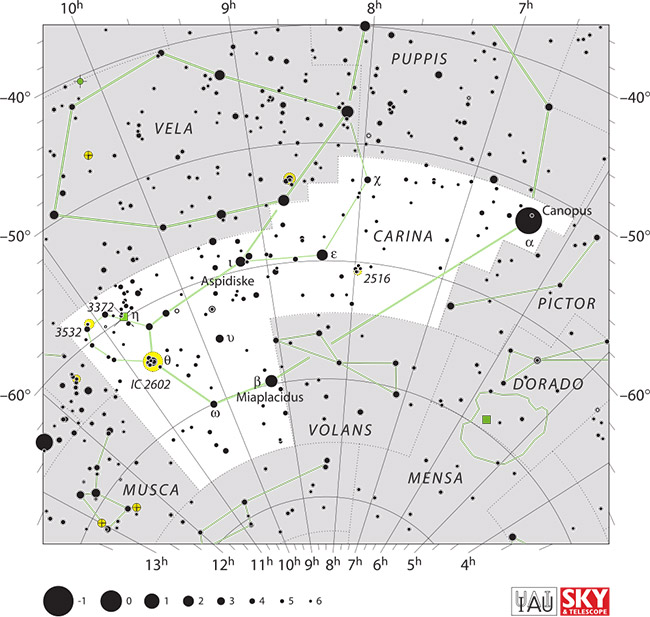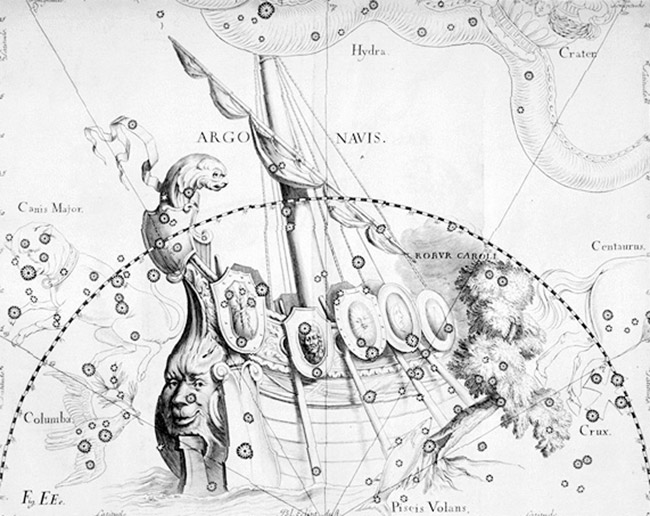Carina – Constellation Facts
 Johannes Hevelius (28 January 1611 – 28 January 1687), Public domain, via Wikimedia Commons
Johannes Hevelius (28 January 1611 – 28 January 1687), Public domain, via Wikimedia Commons
Carina is derived from the Latin language and means “the keel (of a ship).” This constellation was once a part of a larger one called, Arvo Navis, which contained the constellations of Puppis (“the stern”) and Vela (“the sails”) before they were divided into their own constellations. Carina can be located in the second quadrant of the Southern hemisphere and is located specifically between latitudes of +20° and -90°.
Constellation Characteristics
The crooked line with a scoop-like end is the 34th largest constellation in the night sky, occupying 494 square degrees. Carina is also neighbors with Centaurus, Chamaeleon, Musca, Pictor, Puppis, Vela and Volans. In addition, this constellation has eight stars, seven deep space objects and also two meteor showers; the Alpha Carinids and the Eta Carinids.

IAU and Sky & Telescope magazine (Roger Sinnott & Rick Fienberg), CC BY 3.0, via Wikimedia Commons
By IAU and Sky & Telescope magazine (Roger Sinnott & Rick Fienberg) CC BY 3.0, via Wikimedia CommonsPlanetary Systems
Carina has seven deep sky objects. Read on to discover some fascinating facts about these celestial wonders.
- Carina Nebula (Eta Carinae Nebula, NGC 3372): this is one of the biggest diffuse nebulae known today. It surrounds the huge stars of Eta Carinae and HD 93129A and also contains two smaller nebulae; Homunculus Nebula and the Keyhole Nebula.
- Theta Carinae Cluster (Southern Pleiades, IC 2602, Caldwell 102): this open cluster is located 479 light-years away and is visible to the naked eye. As the name indicates, the most luminous star in this cluster is Theta Carinae, a blue-white dwarf.
- Wishing Well Cluster (NGC 3532): composed of approximately 150 stars, this open cluster was the first object observed by the Hubble Space Telescope.
- NGC 3603: this open cluster lies in the “Carina spiral arm” of the Milky Way and is located about 20,000 light-years away. This is a ‘hot-spot’ for astronomers to view as it is relatively bright and close.
- NGC 2808: estimated to be around 12.5 billion years-old, this globular star cluster is one of the biggest in the Milky Way.
- The Diamond Cluster (NGC 2516, Caldwell 96, C96): known for its clarity, this open cluster can be viewed, in good conditions, without binoculars.
- NGC 3293: this open cluster contains around 50 stars with the brightest one being a red giant.
Main Stars
The constellation Carina contains eight main stars that makes up its shape. Let’s explore them further.
- Canopus shines the brightest in the Carina constellation (which will be discussed later in detail).
Eta Carinae is also known by its Chinese name (Tseen She) which means “Heaven’s Altar.” It contains at least two star systems, that when combined, shines four million times brighter than the sun. The biggest star in this system has over 100 solar masses. - Miaplacidus (Beta Carinae) comes in at the second brightest in this constellation and the 29th overall in the night sky. Its name means “placid waters,” taken from the Arabic word for water (miyah) and the Latin word for placid (placidus).
- Avior (Epsilon Carinae) is a double star made up of a K0 III class orange giant and a hot hydrogen-fusing blue dwarf. It shines the 84th brightest in the night sky.
- Aspidiske (Iota Carinae) is a rare white supergiant that shines that of 4,900 Suns! It is also thought to be around 40 million years-old.
- Theta Carinae is located on the Northeastern edge of the Diamond Cross and is classified as a blue-white main sequence dwarf.
- Upsilon Carinae is a double star that consists of a white A-type supergiant and a blue-white B-type giant.
- Omega Carinae is one of the stars that form the Diamond Cross and is considered a blue-white B-type giant.

Johannes Hevelius (28 January 1611 – 28 January 1687), Public domain, via Wikimedia Commons
Johannes Hevelius’ Argo Navis from Uranographia (1690)Most Shining Star
Out of all the stars that make up the Carina constellation, none shine brighter than Canopus. This star is classified as an F-type bright giant and is also the second brightest star in the night sky; 13,600 times brighter than the Sun! It is situated 310 light-years away and is noted for being the most luminous star within 700 light-years.
Mythology & History
Carina does not have any myths associated with it directly; however, it does fit into the constellation of Argo Navis; the ship on which Jason and the Argonauts used to retrieve the Golden Fleece. Argo Navis was known to the Greeks and Carina represents the main body of this ship. In addition, the star known as, Canopus, marks the blade on one of the ship’s steering oars.
Carina is a fascinating constellation, so the next time you are gazing into the night sky, be sure to search out this intriguing figuration of stars.
